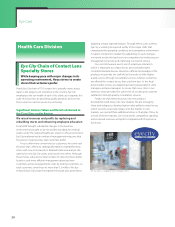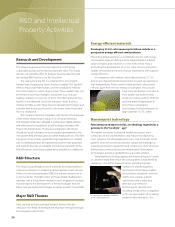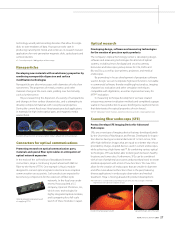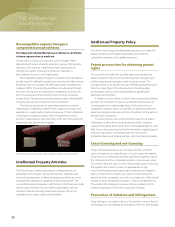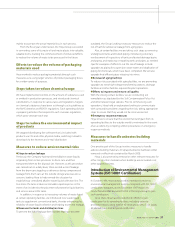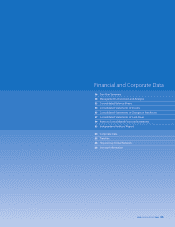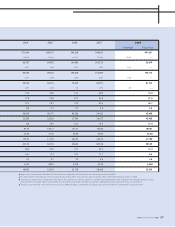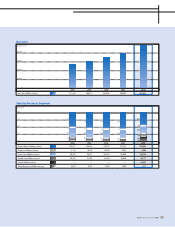Pentax 2008 Annual Report Download - page 32
Download and view the complete annual report
Please find page 32 of the 2008 Pentax annual report below. You can navigate through the pages in the report by either clicking on the pages listed below, or by using the keyword search tool below to find specific information within the annual report.
The expansion and sustainability of a company’s business must be
matched by the willingness to take on greater responsibility for
issues of social concern, such as environmental protection. Hoya
aims to grow in a manner that enables harmonious coexistence
with the earth’s environment. Hoya is engaged in a broad range of
environmental protection activities that aim to reduce the
environmental impact of its operations.
In 1976, Hoya established pollution countermeasure committees
at each of its operating bases. In 1993, the Company set up an
environmental protection organizational structure that addresses
environmental activities for each operating base companywide.
At the same time, based on the Corporate Mission and the
Management Principles for the Hoya Group, we drew up the Hoya
Group’s Environmental Philosophy and a set of Fundamental
Environmental Principles to serve as standards of behavior. Since
that time, we have persevered in our efforts to reduce our
environmental impact.
In 1997, Hoya amended its Philosophy of Environment and
Fundamental Principles of Environment, based on which it has
been carrying out groupwide environmental protection activities
since then. At the same time, we have formulated Group
Environmental Management, System Regulations. The
Environmental Headquarters’ meetings directed by the CEO
establish and manage environmental protection systems and
structures as the most senior body responsible for the
environment, and promote and oversee all of the Hoya Group’s
environmental protection activities.
Based on its Philosophy of Environment and Fundamental
Principles of Environment, the Hoya Group has worked to
eliminate the environmental impact of its activities. This section
looks at several ecological activities the Hoya Group carried out
during the fiscal year under review.
To cut CO2 emissions, we have converted operating locations
from heavy oil to liquefied petroleum gas, and again to natural gas.
In line with these efforts, Hoya took a number of initiatives to
curtail CO2 emissions from fuel use by cutting back on the
amount of fuel used. These included implementing thermal
management systems in steam boiler facilities, monitoring fuel
combustion conditions, maintaining optimal air-fuel ratios and
reducing the number of ignitions necessitated by equipment
starts and stops.
The Company also implemented ice thermal storage systems,
adopted high-efficiency electrical transformers and replaced
outdated equipment with the best new models to keep facilities
up to date. We also promoted greenery on rooftops at operational
facilities and on balconies, introduced policies permitting lighter
clothing in offices year-round, adjusted room air temperatures to
more appropriate levels, managed lighting in smaller units of
space by installing draw cord switches and maintained a policy of
turning off room lighting during break times.
At certain operating facilities, we have introduced ozone
treatment devices and extended the re-use of factory waste water.
In the past, applications for re-used waste water were limited to
water for toilet flushing and air-conditioning coolant water, due to
the effect on water quality. However, the implementation of
ozone treatment has allowed for a higher level of purification. At
operating facilities, approximately 30% of waste water is used as
pure water for production.
Furthermore, we are re-using underground spring water as a
coolant in cooling devices for molding machines. At certain
operating facilities overseas, we have also instituted water quality
monitoring to enable nearly 100% re-use of waste water used in
the final rinse and cleaning phases.
Hoya reduced its volume of waste disposal through such efforts as
recycling polishing sludge emitted by operating facilities as raw
material for concrete, decreasing sludge quantities by improving
waste water treatment processes, carrying out thermal recycling
of discarded plastics and their conversion to valuable, saleable
items, and collecting and recycling the cutting lubricant adhering
to cut scraps.
In addition, closing the gap between the total volume of glass
used and the volume of quality glass (the material loss volume)
helped further cut down on waste. To achieve this, we first sought
Environmental
Initiatives
Environmental Protection Support
Systems
Examples of Activities Aimed at
Reducing Environmental Impact
Initiatives designed to reduce CO2
emissions and save energy
Efforts to reduce water consumption
Steps taken to reduce waste disposal volumes
30


